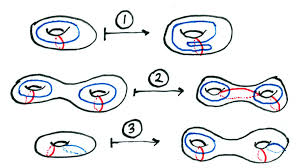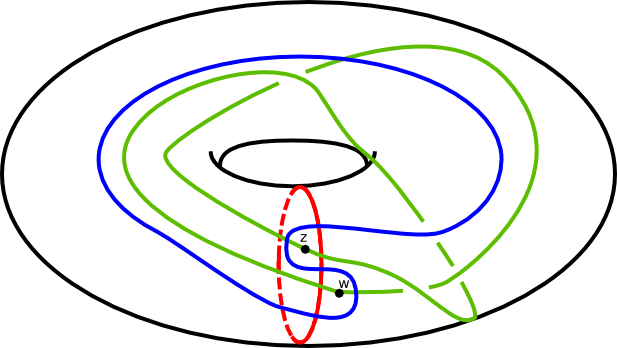

Thursday 24th September: Mark Powell, introduction to knot concordance, the Seifert form, the Alexander polynomial and Levine-Tristram signatures.
Thursday 1st October: Nima Hoda, Heegaard splittings and Heegaard diagrams of 3-manifolds.
Thursday 8th October: Nima continued, Heegaard diagrams of knot complements, followed by Matthias Nagel, the symmetric product.
Thursday 15th October: Matthias Nagel, lagrangian tori, Whitney discs and the definition of Floer chain complexes.
Thursday 22nd and Thursday 29th October: Clovis Kari, Spin-c structures on 3-manifolds and their relation to Heegaard Floer groups.
Thursday November 5th: Ying Hu, the Maslov index, understanding discs in the symmetric product in terms of domains on the Heegaard diagram, computing some basic examples.
Thursday November 12th: Matthias Nagel, knot Floer homology, Alexander grading, filtered chain complexes with U action, examples, definition of tau.
Thursday November 19th: Liam Watson, definition of Upsilon, some properties.
Thursday November 26th: Mark Powell, Absolute grading of Gripp and Huang via homotopy classes of vector fields.
Thursday December 3rd: Matthias Nagel, Surgery exact triangle and maps induced by cobordisms.
FRIDAY December 4th, Guest lecture CIRGET seminar by Adam Levine. Satellite operators and piecewise linear concordance.
Thursday December 10th: Ying Hu, Absolute rational grading and d-invariants.
Clay Lectures on Heegaard Floer homology: Part 1 and Part 2, Peter Ozsvath, Zoltan Szabo.
Lectures from Park City, page 209 of this.
Introduction to the basics of Heegaard Floer homology, Bijan Sahamie.
Survey article: Heegaard diagrams and holomorphic disks, Peter Ozsvath, Zoltan Szabo.
Background on Floer theory and how this led to Heegaard Floer: Floer theory and low dimensional topology, Dusa McDuff.
ICM proceedings paper: Heegaard diagrams and Floer homology, Peter Ozsvath, Zoltan Szabo.
Original Annals reference 1: Holomorphic disks and topological invariants for closed three-manifolds, Peter Ozsvath and Zoltan Szabo.
Original Annals reference 2: Holomorphic disks and three-manifold invariants: properties and applications, Peter Ozsvath, Zoltan Szabo.
A survey of Heegaard Floer homology, Andras Juhasz.
Understanding domains: A cylindrical reformulation of Heegaard Floer homology, Robert Lipshitz.
Understanding domains: An algorithm for computing some Heegaard Floer homologies, Sucharit Sarkar, Jiajun Wang.
Undertanding gradings: An absolute grading on Heegaard Floer homology by homotopy classes of oriented 2-plane vector fields , Vinicius Gripp and Yang Huang.
Knot Floer homology: Holomorphic disks and knot invariants, Peter Ozsvath, Zoltan Szabo.
d invariants and 4-manifolds: Absolutely Graded Floer homologies and intersection forms for four-manifolds with boundary , Peter Ozsvath, Zoltan Szabo.
All the formal properties in one place: The geography and botany of Heegaard Floer homology, Matthew Hedden, Liam Watson.
The tau invariant: Knot Floer homology and the four-ball genus, Peter Ozsvath, Zoltan Szabo.
First paper on Upsilon: Concordance homomorphisms from knot Floer homology, Peter Ozsvath, Andras Stipsicz, Zoltan Szabo
Another account: Notes on the concordance invariant Upsilon, Charles Livingston.
Upsilon used to compute four ball genera:The four-genus of connected sums of torus knots, Charles Livingston, Cornelia Van Cott.
Two papers on Upsilon by Shida Wang: The genus filtration in the smooth concordance group and On the First Singularity for the Upsilon Invariant of Algebraic Knots.
An application of Upsilon to unoriented surfaces: Unoriented knot Floer homology and the unoriented four-ball genus, Peter Ozsvath, Andras Stipsicz, Zoltan Szabo.
The epsilon invariant: The knot Floer complex and the smooth concordance group, Jennifer Hom.
Another new concordance invariant: Four-ball genus bounds and a refinement of the Ozsvath-Szabo tau-invariant, Jennifer Hom, Zhongtao Wu.
Concordance maps in knot Floer homology, Andras Juhasz, Marco Marengon.